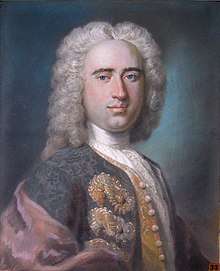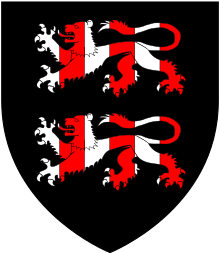Stephen Fox-Strangways, 1st Earl of Ilchester


_Arms.png)
Stephen Fox-Strangways, 1st Earl of Ilchester PC (12 September 1704 – 26 September 1776) was a British peer and Member of Parliament. [2]
Ilchester was the son of Sir Stephen Fox and his second wife Christiana Hope. Henry Fox, 1st Baron Holland, was his younger brother and Charles James Fox his nephew. He was educated at Eton and Christ Church, Oxford before taking the Grand Tour. On his father's death in 1716 he inherited Redlynch Park in Somerset, where he improved both the house and gardens.
He was appointed to the lucrative post of Paymaster of the Forces under Charles II as paymaster of the forces, and bought further land in Wiltshire and Somerset.
He was elected to the House of Commons for Shaftesbury in 1726, a seat he held until 1741. The latter year he was raised to the peerage as Lord Ilchester, of Ilchester in the County of Somerset, Baron of Woodford Strangways in the County of Dorset. Six years later he was created Lord Ilchester and Stavordale, Baron of Redlynch, in the County of Somerset, and in 1756 he was even further honoured when he was made Earl of Ilchester. The peerages were created, in default of male issue of his own, with remainder to his younger brother Henry. In 1763 he was admitted to the Privy Council.
Stephen Fox was the lover of Lord Hervey for a period of ten years, from 1726 to 1736. There exist many passionate letters between the two.[3] Hervey initially favoured Stephen's brother, Henry Fox, but when charmingly rebuffed paid infatuated court to Stephen. His relationship with Lord Hervey ended only when a marriage was arranged with thirteen-year-old Elizabeth Horner, daughter of Thomas Strangways Horner and Susanna Strangways, in 1735. In 1758, Lord Ilchester assumed the additional surname of Strangways.
Lord and Lady Ilchester's children were:
- Lady Susannah Sarah Louisa Fox-Strangways, called Susan (1743 – 1827), married Irish actor William O'Brien (actor)
- Henry Thomas Fox-Strangways, 2nd Earl of Ilchester (9 August 1747 – 5 September 1802)
- Lady Lucy Fox-Strangways (1748 – 16 August 1787), married Colonel Hon. Stephen Digby
- Lady Christian Henrietta Caroline Fox-Strangways, called Harriet (3 January 1749/50 – 21 July 1815), married Colonel John Dyke Acland
- Lt.-Col. Hon. Stephen Strangways Digby Fox-Strangways (3 December 1751 – 12 March 1836)
- Lady Frances Muriel Fox-Strangways (Aug 1755 – 5 May 1814), married Valentine Richard Quin, 1st Earl of Dunraven and Mount-Earl
- Rev. Hon. Charles Redlynch Fox-Strangways (27 April 1761 – 4 November 1836), married Jane Haines
He died in September 1776, aged 72, and was succeeded by his son Henry Thomas Fox-Strangways.
Stephen Fox appears as "Stephen Reynard", later Lord Ivell and Earl of Wessex, in the short story "The First Countess of Wessex" by Thomas Hardy, collected in A Group of Noble Dames.
Notes
- ↑ Montague-Smith, P.W. (ed.), Debrett's Peerage, Baronetage, Knightage and Companionage, Kelly's Directories Ltd, Kingston-upon-Thames, 1968, p.607, Earl of Ilchester
- ↑ "FOX, Stephen (1704-76), of Redlynch, Som". History of Parliament Trust. Retrieved 16 September 2018.
- ↑ "The Gay Love Letters of John, Lord Hervey to Stephen Fox"; excerpts from My Dear Boy: Gay Love Letters through the Centuries (1998), edited by Rictor Norton, accessed 26 May 2010
References
- Kidd, Charles, Williamson, David (editors). Debrett's Peerage and Baronetage (1990 edition). New York: St Martin's Press, 1990,
- thePeerage.com
- Tillyard, Stella. "Aristocrats: Caroline, Emily, Louisa and Sarah Lennox, 1740-1832"
| Peerage of Great Britain | ||
|---|---|---|
| Preceded by new creation |
Earl of Ilchester 1756–1776 |
Succeeded by Henry Thomas Fox-Strangways |